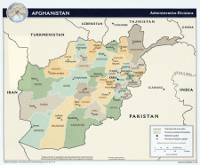Yesterday Coalition forces killed two senior Islamic Movement of Uzbekistan commanders in an airstrike in the northern Afghan province of Samangan, while another IMU leader was captured during a raid in Balkh.
In Samangan, the International Security Assistance Force killed Bilal Konduzi and Shad Mohammad in a “precision air strike” in a remote area in the district of Dara Soof Payan. Following the strike, ISAF sent in a ground team and confirmed that the two commanders and four other fighters had been killed.
Konduzi served as a liaison to the Taliban and “maintained significant connections to IMU military leaders” in the northern Afghan provinces of Kunduz, Baghlan, Takhar, and Badakshan, ISAF stated in a press release. He “was involved in the facilitation and planning of suicide operations throughout northern Afghanistan,” and also trained suicide bombers to carry out attacks.
Mohammad commanded the IMU network in Samangan and was “in direct communication with Burkah district-based IMU leaders associated with Mazar-e-Sharif attack planning.”
In Balkh province yesterday, ISAF and Afghan special operations teams captured an IMU military commander and several fighters during a raid in Mazar-e-Sharif.
The IMU commander, who was not named, led “a foreign fighter force and is involved in the recruitment and training of suicide bombers,” ISAF stated. He also was “associated with several members of the Taliban and IMU leadership throughout Balkh, Kunduz, Baghlan, and Takhar provinces.” Intelligence indicated that the commander was in Mazar-e-Sharif to direct suicide attacks in the provincial capital during Nawroz celebrations.
Yesterday’s operations in Samangan and Balkh are likely linked to the March 8 raid in the Burkah district in Baghlan that targeted a Taliban commander who leads a large group of foreign fighters. The Taliban commander leads “approximately 80 foreign fighters of Uzbek, Chechen and Tajik descent,” ISAF stated.
The March 8 raid in Baghlan was the first against the Islamic Movement of Uzbekistan reported by ISAF since Jan. 25, when Nurullah Bai, a high-ranking leader, was killed during a raid in Takhar province.
Al Qaeda and the allied Islamic Movement of Uzbekistan maintain a strong presence in the northern Afghan provinces of Baghlan, Kunduz, and Takhar. The two allied terror groups have been establishing strongholds in the Afghan north, and are known to operate training camps in Kunduz. In addition, top leaders of the Islamic Movement of Uzbekistan have integrated into the Taliban’s shadow government in the provinces of Baghlan, Kunduz, and Takhar.
Background on the Islamic Movement of Uzbekistan in the region
The Islamic Movement of Uzbekistan’s leadership cadre is based in Pakistan’s Taliban-controlled tribal agency of North Waziristan, and operates primarily along the Afghan-Pakistani border and in northern Afghanistan. According to one estimate, more than 3,000 Uzbeks and other Central Asian fighters are sheltering in North Waziristan.
Since Sept. 1, the US has ramped up airstrikes against the terror groups in North Waziristan, with 50 strikes Predator strikes in the area. Many of the strikes targeted cells run by the Islamic Jihad Group, an IMU offshoot, which were plotting to conduct Mumbai-styled terror assaults in Europe. A Sept. 8 strike killed an IJG commander known as Qureshi, who specialized in training Germans to conduct attacks in their home country.
The IMU’s former leader, Tahir Yuldashev, was killed in a US Predator airstrike in South Waziristan in September 2009. Yuldashev sat on al Qaeda’s top council, the Shura Majlis. He has been replaced by Abu Usman Adil.
Islamic Movement of Uzbekistan fighters often serve as bodyguards for top Pakistani Taliban and al Qaeda leaders. The IMU fights alongside the Taliban in Pakistan and Afghanistan, and has stepped up attacks in Central Asian countries as well.








